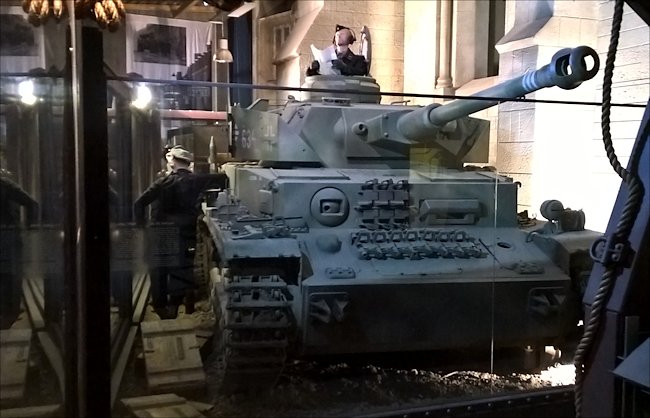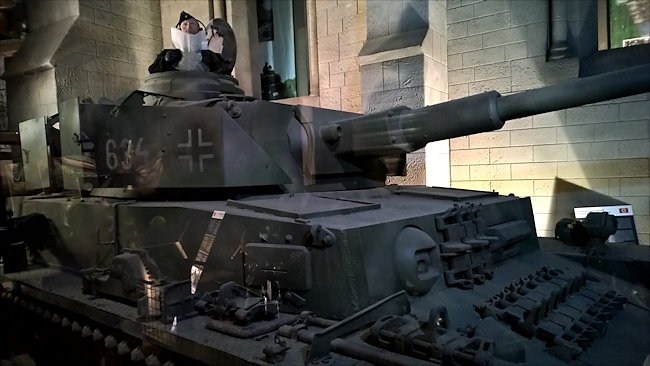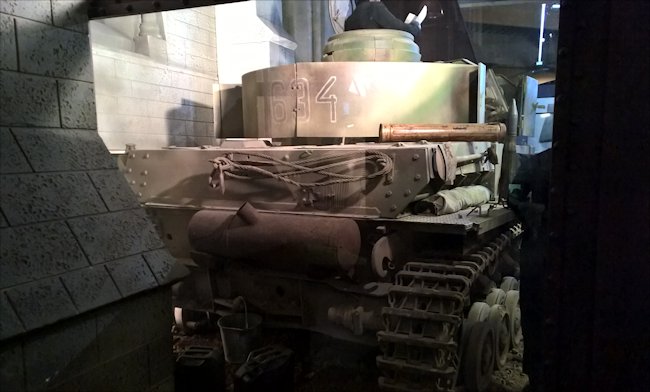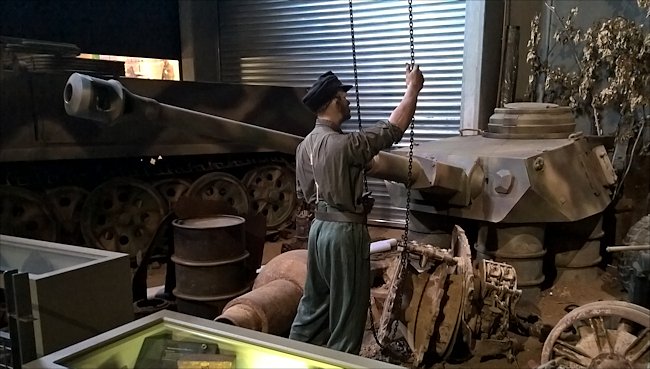Overlord Museum Panzer IV Tank Ausf H
This Panzer IV tank had been left rusting away outside the war museum in Falaise. When the Museum closed in 2012 it was rescued and restored by the Overlord Museum close to Omaha Beach near the small village of Colleville-sur-Mer, Normandy, France. It arrived at its new home in March 2013. The Panzer IV was the most common tank used against the Allies in the battle for Normandy in the summer of 1944.

Panzer IV Tank Ausf H tank at the Overlord Museum near Omaha Beach
Location
The nearest village to the Overlord Museum is Colleville-sur-Mer. It is on the D514 costal road Hameau du Bray. You cannot miss it as there is a M4A1 Sherman tank, M10 Wolverine Tank Destroyer and British Sexton self-propelled artillery gun outside the front by the roundabout. It is very near Omaha Beach and the American Military Cemetery.
Specification
The Panzer IV Ausf H was powered by a 12 cylinder Maybach HL 120 TRM V12 engine that produced 296 ho. This gave the tank a maximum road speed of 38 km/h (24 mph) and only 16 km/h (10 mph) off road. It had an operational range of around 200 km (120 miles). The tank had a crew of 5 ; commander, driver, gunner, loader, hull machine-gunner/radio operator. They were protected by armour that ranged in thickness form 20mm to 80mm.
The main armament was a 75mm KwK 40 L48 gun that could fire high explosive HE shells as well as armour piercing AP rounds. It was built with two 7.92mm MG 34 machine-guns, one next to the main gun in the turret and another in a ball mounting in the hull. It weighed 25 tonnes. It was produced in various different versions from 1936 to 1945. Over 8,500 were guilt.

This Panzer IV Tank Ausf H tank has skirt armour around its turret
Side Skirt Schurzen Armour
If you have a look at the turret in these photos you will see that additional spaced armour was added around the outside of the turret. The tank would also have had large panels of 5 mm thick spaced armour plating Schurzen 'skirts' that covered the hull and tracks. These have not been replaced on this restored Panzer IV Ausf H example.
They were designed to protect the tank from soviet anti-tank rifles on the Eastern Front but they also worked against American made Bazooka hollow charge rockets. The additional armour plating would take out the energy in the anti-tank round so that it could no longer penetrate the tanks hull or turret. Some of the side skirt armour used on Panzer IV tanks on the Western front were made of mesh rather than metal plate.

Panzer IV Tank Ausf H tank rear view through a large glass window of the display.
Development of the Panzer IV Ausf. H tank
Until the deployment of the American-built M3 Lee-Grant and M4 Sherman tanks to the desert the Germans had the most powerful tank in the theatre in the shape of the German Panzerkampfwagen IV tank.
The prototype Panzer IV tank appeared in 1937 and, built in various models, it would remain in production throughout the war. Indeed, it has the distinction of being the only tank to continue to be built and serve in action from 1939 to 1945. In all some 8,540 gun tanks were built of which around 3,774 Ausf. H were built, making it the most numerous version.
The Panzer IV had the specialist designation of SdKfz 161 and the Ausf. H was produced by three companies — Krupp-Gruson, Vomag and Nibelungenwerke between April 1943 and July 1944. There were a further 161 chassis completed for the Ausf. H tank that are understood to have been used on other projects including SPGs.
The company of Nibelungenwerke on its own built a further 1,758 Ausf. J tanks between June 1944 and March 1945, which made them among some of the last tanks to be produced in a collapsing Germany. The Ausf. J had a larger fuel tank but it was still armed with the 75mm-calibre KwK40 L/48 for which eighty-seven rounds of ammunition were carried.

This Panzer IV Tank tank turret is used in a diorama representing a field repair unit of the Wehrmacht, along with an original German field gantry crane and disabled Panther tank.
The basic Panzer IV Ausf. H measured around 23ft long, 9,4ft wide and 11,5ft to the top of the turret. It was fitted with a rear-mounted Maybach HL120TRM V-12 diesel engine with six forward and one reverse gear, which developed 300hp at 3,000rpm to give road speeds of up to 25mph on roads and 12mph cross-country. The Panzer IV had a combat range of about 125 miles when operating on roads and could cope with vertical obstacles 2ft high, span gaps of over 7ft wide and ford water obstacles more than 2ft deep.
Among the characteristics that identified the Ausf. H from earlier versions was an increase in the level of armour plate to a maximum of 80mm and other internal modifications that were not immediately obvious. Externally, a cupola mount for a machine gun was fitted on the turret and the four return rollers were changed to an all-steel design.
There were eight road wheels with the drive sprocket fitted to the front and the idler wheel to the rear. The turret had a full 360 degree capability and was powered by an electric motor. The gun could elevate to +20 degrees and depress to -8 degrees, allowing it to engage a wide range of ground targets.
The Ausf. H was fitted with brackets to allow sections of armour plate to be attached to the sides to protect the road wheels from anti-tank projectiles. These armour plates were called Schurzen and had been used on the Ausf. G and were also used on the Ausf. J version. Similar attachments were fitted around the sides of the turret; these were permanently attached, but did not hinder traverse.
It was explained that the side plates were often lost in battle and certainly one of the plates on the left-hand side was invariably left off the vehicle where the fuel filling point was. This would have been a tactical decision because to remove and replace the plate would have increased refuelling time and so it was usually left off the vehicle.
Versions of the Panzer IV served in all theatres of the war, from Poland in 1939, France 1940 and Russia from 1941 onwards, along with the campaigns in North Africa and Italy. It is believed that when the Allies landed in Normandy on 6 June 1944, most of the estimated 748 Panzer IV tanks in service with the nine panzer divisions in France were Ausf. H. During the war versions of the Panzer IV were also supplied to Germany's allies, including Hungary and Bulgaria.
D-Day 1944 books

